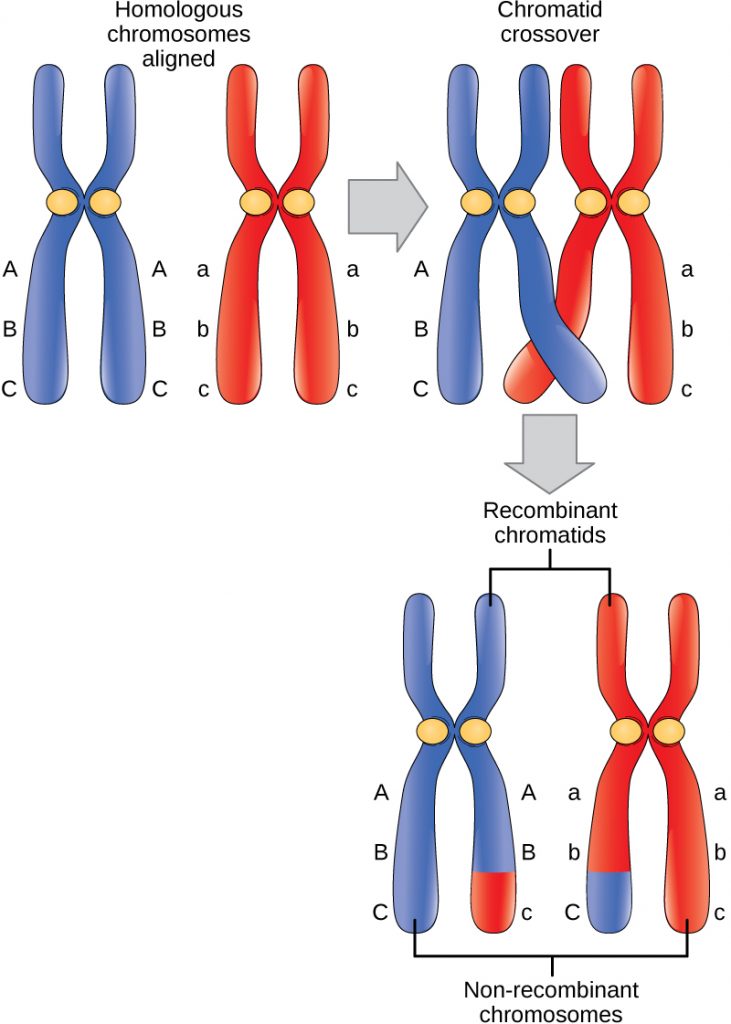Contents
Genetic Diversity: Meiosis & Mutations
Meiosis
Genetic variation can be introduced in a variety of ways, such as during meiosis cell division, mutations, and the random fertilization of gametes.
Meiosis is the type of cell division that creates genetically different gametes. Unlike in mitosis, there are two nuclear divisions in this process, which results in four haploid daughter cells. Haploid (n) = one copy of each chromosome, Diploid (2n) = two copies of each chromosome.
The genetic differences are introduced by two key processes in meiosis:
- Independent segregation of homologous chromosomes
- Crossing over between homologous chromosomes

The above diagram outlines the stages in meiosis. Before cell division, interphase occurs in which the DNA and organelles double. As meiosis involves two nuclear divisions, the descriptions of the processes can be stated as being in meiosis I or meiosis II, referring to the stage of nuclear division. Both stages include prophase, metaphase, anaphase, telophase, and cytokinesis.
Crossing Over
During prophase, the chromosomes condense and become thicker. The homologous chromosomes pair to form bivalents. Crossing over of genetic material can occur between the chromatids of bivalents. Where the chromatids cross over is called the chiasma - there can be more than one chiasma at a time. Breaks can occur in the genetic material, and parts of the chromatids are exchanged between the homologous pairs. This results in new combinations of alleles in the resulting gamete.


Independent Segregation
During metaphase I, in meiosis I, the homologous pairs of chromosomes line up opposite each other on either side of the equator. As there are 23 different homologous pairs, there are 8,388,608 different ways the pairs could assort themselves (2 to the power of 23). It is random each time which side of the equator the paternal and maternal chromosome of each homologous pair align at the equator, and as a result, each gamete receives different combinations of the maternal and paternal chromosomes.
Mutations
A mutation is a change in the DNA, and this could result in a non-functioning protein being created. However, some mutations result in the creation of a protein that provides an advantage to an organism. All alleles of genes are a result of a mutation.
There are two key types of mutations: mutations in the bases of a particular gene or mutations in the number of chromosomes.
Gene Mutations
A mutation in a gene is a change in the base sequence of the DNA. Gene mutations randomly occur during DNA replication. These random mutations are more likely to occur if you are exposed to mutagenic agents, which can interfere with DNA replication. These include high-energy radiation (UV light), ionizing radiation (Gamma rays and X rays), and chemicals (carcinogens such as mustard gas and cigarette smoke). A gene mutation could result in either a base being deleted or substituted for a different one, e.g., TAC CCA AGT GGC - original DNA sequence TAC ACA AGT GGC - base substitution mutation TAC CAA GTG GC - base deletion mutation.
A base substitution may be ‘silent,’ meaning that the new codon still codes for the same amino acid. This is because the genetic code is degenerate (multiple codons can code for the same amino acid). Base deletions result in a frameshift. Removal of one base changes all of the subsequent codons, as can be seen above, which is more harmful as multiple amino acids may be incorrectly coded for.
Chromosome Mutations
Mutations in the number of chromosomes can arise spontaneously by chromosome non-disjunction during meiosis.
Changes in the number or structure of whole chromosomes can arise spontaneously due to chromosome non-disjunction during meiosis. Non-disjunction is when the chromosomes or chromatids do not split equally during anaphase. This can occur in two forms:
- Changes in whole sets of chromosomes occur when organisms have three or more sets of chromosomes rather than the usual two. This condition is called polyploidy and mainly occurs in plants.
- Changes in the number of individual chromosomes.
Sometimes individual homologous pairs of chromosomes fail to separate during meiosis. This is non-disjunction and usually results in a gamete having one more or one fewer chromosomes. On fertilization with a gamete that has the normal number of chromosomes, the resultant zygote will have more or fewer chromosomes than normal in all their body cells. E.g., Down’s syndrome is 3 copies of chromosome 21.


- Which type of gene mutation is likely to be the most damaging and why?
- Frameshift
- A student wrote that UV light increased the likelihood of mutations in the protein that the cell made. Why is this not correct?
- UV light affects DNA, not protein.
- Evaluate this statement: “Sunbathing exposes your body to UV light which causes mutations to occur”.
- Sunbathing exposes your body to a mutagenic agent (UV light), which can cause mutations to occur in DNA.
- What is a mutation?
- A mutation is a change in the structure of DNA.
- What causes mutations?
- Errors during DNA replication cause mutations.
